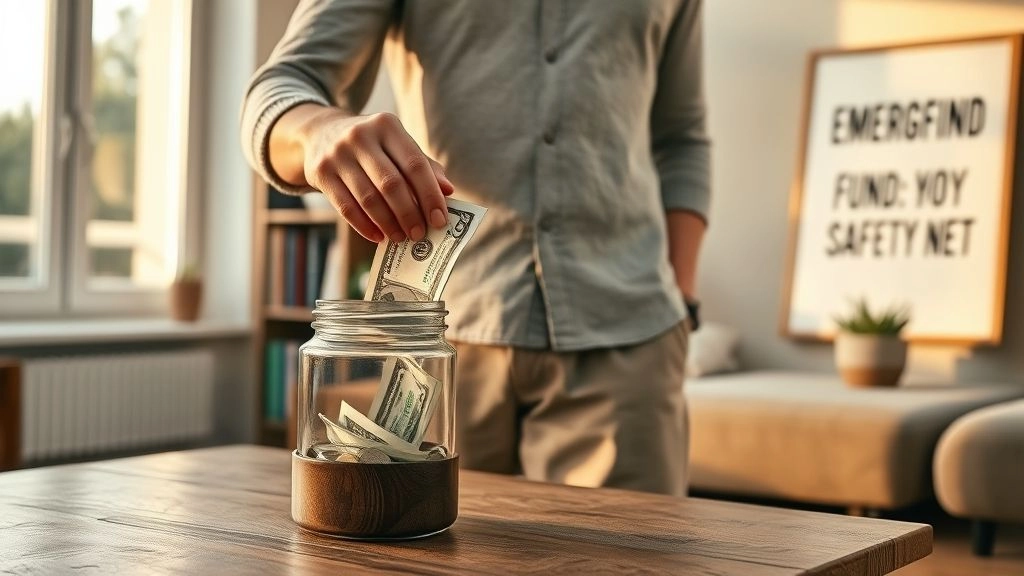Is Your Wallet Ready?
Let me ask you something real quick. Have you ever hit a moment when your fridge suddenly dies, your car coughs up a $1,800 repair bill, or—my personal “favorite”—your kid turns up with a mysterious rash on a long weekend? (Yeah, urgent care isn’t cheap.) If so, I see you. You’re not alone, and honestly, most of us have learned the hard way that bills don’t care if payday’s two weeks away.
The first reason to save money is to build your fund. Forget those dull “textbook” rules about savings for a sec—this is real life. An emergency fund isn’t just a number in your bank app. It’s the difference between panic and a deep breath. Between grabbing your credit card with a sigh and calmly paying your mechanic, doctor, or plumber. So let’s talk about this fund… why it matters, where to start, and how you can make it happen, even if you swear there’s nothing left after groceries. Sound good?
Why Start with an Emergency Fund?
Isn’t This Just Hoarding?
Honestly, I used to roll my eyes at the “pay yourself first” advice. Didn’t saving just mean you’d be missing out, while your money sat there doing nothing? Actually… no. The magic of an emergency fund is simple: it keeps the rest of your budget safe, so you can keep living your life—even when life goes sideways. I read once that the first reason to save money is to build your fund because it acts like a buffer between you and disaster. Like airbags for your wallet.
If you think about it, life’s full of surprises—some fun, some expensive. Most people never expect the everyday emergencies: car repairs, medical bills, lost jobs. Simon Powley from Kitsap Credit Union put it best: it’s not about getting rich quick—it’s about buying peace of mind (Smart saving strategies: How to build your emergency fund).
And you know what? Having money ready for the next curveball is way better than relying on credit. (Been there, paid that interest.)
So… What’s a Real Emergency?
I get it. It’s tempting to dip into your stash when that 70% off sign flashes at you, or a sweet vacation deal pops up. But let’s get real. A true emergency is something that absolutely, positively has to be dealt with now. Lost your job? Yep, crack the fund. Burst pipe or unexpected dental work? Go for it.
But a spontaneous trip to Cancun? Sorry. That can wait. (At least, if you ask your future self—and your bank account.) Constituting a true emergency will help you determine when to use your emergency funds, or whether to save up and make a purchase later on. Having some ground rules is kind of freeing, honestly. Less guilt, less “should I/shouldn’t I?” stress.
Here’s a classic trap: if you make a late credit payment, you might see the lender add all sorts of sneaky fees, and missing even a single emergency can compound your money troubles.
Car Trouble & Real-Life Ouch Moments
Just last year, my friend Josh hit a pothole and killed his suspension. No emergency fund. He charged it to his card… and spent six months digging out from the interest. Meanwhile, my neighbor Julie? She’d squirreled away $4,000 when things were good. When her water heater exploded, she just paid the bill, shrugged, and moved on with her life. (She even slept through the night. Imagine!)
| Scenario | With Emergency Fund | Without Emergency Fund |
|---|---|---|
| $1,800 Car Repair | Pay cash, stress gone. Back on the road. | Charge it. Interest piles up. Six-month headache. |
| Medical Bill | Cover cost immediately. No long-term impact. | Dip into rent money. Start a debt snowball. |
How Much Is “Enough”?
Three Months or Six?
I know—big savings targets feel impossible. Experts like Karthik Rangappa suggest going for three to six months of living expenses (Why saving money is important?). But hold up: don’t let big numbers freak you out. Start small. First, just aim for $500. Then $1,000. Then, well, just keep going.
If you have a steady job with sick leave and health insurance, three months might do the trick. But if you freelance, or if your income bounces around like a rubber ball, shoot for six months. And yes, it feels like climbing a mountain, but every dollar is a step higher—and you’re building confidence with every win.
Find Your Number: Easy Math
Let’s make this less “math class,” more real life. Add up your essentials:
- Rent or mortgage
- Food and groceries
- Utilities
- Insurance
- Gas or transport
- Minimum loan payments
Multiply that by 3. Or 6, if you’re an overachiever. That’s your target. And remember: it’s way better to have $500 in your account than zero dollars and a stack of hope.
| Lifestyle | Monthly Expenses | 3-Month Goal | 6-Month Goal |
|---|---|---|---|
| Single, steady job | $2,200 | $6,600 | $13,200 |
| Couple, variable income | $4,000 | $12,000 | $24,000 |
| Frugal solo | $1,500 | $4,500 | $9,000 |
Have you already started or hit one of those targets? Celebrate—even if it’s just with a victory dance in your kitchen.
The 1-3-6 Method: Bite-Sized Wins
Here’s my favorite hack, picked up from the Personal Finance Podcast: save 1% of your income as a “toe in the water.” Then bump that to 3 months, then 6. Keeps you from feeling overwhelmed, and gives you momentum, fast. Every time you add another hundred in, give yourself a mental high-five. (I do.)
Where to Keep Your Savings?
Piggy Bank or High-Yield?
Okay, so your money’s growing. Where should you keep it? Here’s where it gets fun. Old-school piggy banks are cute, but grown-ups get more from high-yield savings accounts. Money market accounts are even better if you can find one with no weird fees—Simon Powley suggests shopping credit unions, since they often pay a tiny bit more interest (Smart saving strategies: How to build your emergency fund). Why not let your emergency cash quietly earn for you?
Other Options for the Bold
Have a home? Home equity lines are another tool—kind of like a secured credit card, but cheaper and safer. Have a 401(k)? You can set up tiny automatic deductions—you’ll barely notice and, one day, you’ll check the balance and grin. (Trust me, it feels good.)
The bottom line? Your emergency fund should be easy to access in a true crisis, but just far enough out of reach that you’re not tempted to “borrow” for pizza night.
Still figuring out where to park your cash? Explore more practical tips in the three reasons to save money are ramseyclassroom summary—it’s full of simple, actionable advice. Or, if you’re looking for more personal answers, see the three reasons to save money are ramseyclassroom answers.
Quick Pro Tips (Tried and Tested)
- Automate It: Set up a recurring transfer—$20 or $50 per week. Makes saving mindless and kind of fun.
- Use Windfalls: Drop part of your tax return or birthday money into the fund. Watching it grow in leaps? Satisfying.
- Label Your Account: Literally! Call it “Do Not Touch” or “Safety Fund.” This helped me not dip in just because I was “curious.”
- Ignore Interest… at First: Getting 4% is awesome, but don’t get hung up. Security trumps yield early on.
Common Traps (& How to Dodge)
Debt vs. Emergency Fund?
Some folks ask, “Should I pay off debt or build my fund?” The honest answer? Both. Start with a tiny fund—say, $500 or $1,000—so you’re not forced back into more debt as soon as something goes wrong. Then, whittle down your high-interest balances. It’s like patching the hole in your bucket and filling it at the same time.
Besides, as if you make a late credit payment, you might see the lender add some nasty fees that just, ugh, make everything harder. Protect your progress.
Isn’t Saving “Boring”?
Listen, saving can sound snoozy. But I promise, it’s actually kind of thrilling to watch your fund grow. And it changes you—seriously. Humphrey, a finance YouTuber, talks about how hitting $10K in savings shattered his mental barriers. Suddenly, he felt less anxious about work, more confident to tackle new projects or turn down a gig he didn’t want to do. (And, yeah, that confidence is contagious.)
By the way, nerding out with numbers isn’t just for the ultra-frugal; bloggers like Mr. Money Moustache and My Frugal Adventures turn this lifestyle into something inspiring, not restrictive (best frugal blogs for budget-friendly living).
How Do You Keep Hands Off?
Ah, temptation! I’ll admit, the latest phone or a fancy espresso maker has called my name. My trick? I actually wrote down the emergencies that “count” for me: Job loss, health issues, car repairs. Everything else? Wait a week—if it still feels urgent, maybe it’s worth using the funds…but almost always, the urge fades.
Want more clarity? Check out how the third reason to save money is for long-term financial goals (so you can say yes to more of what matters, guilt-free).
Bonus: Sharing “How I Saved” Stories
I took inspiration from the Frugal Queen couple—living in Brittany, France on a tight budget. Rather than eating out or grabbing the “deal of the day,” they put their spare coins in a literal jar, building up enough to handle a surprise car breakdown. No, it wasn’t a fortune, but it kept the lights on and the landlord happy. Frugal wins, wherever you are.
Wrapping It Up (and Winding Down the Worry)
If you’ve stuck with me this far—heck yes! I hope you’re feeling ready to start (or supercharge) your own starter fund. Remember, the first reason to save money is to build your fund. It’s not about being miserly, it’s about gaining the freedom to sleep tight at night—even if the roof starts leaking.
Let’s recap the steps: prioritize emergencies before luxuries; start wherever you are, even if it’s just $20 this month; automate what you can; and stash your savings in an account that’s easy to access (but not too easy to raid at midnight when that “must have” gadget is on sale).
Don’t forget, curiosity pays off—explore the three reasons to save money are ramseyclassroom summary for deeper dives and real-world stories. Or, if you prefer short and sweet, the three reasons to save money are ramseyclassroom answers delivers quick answers.
So, what’s your next move? Will you set up that first $50 transfer? Will you dig out your old piggy bank, just for kicks? Drop a comment—or just a “done!”—when you start building your fund. I’ll be over here, rooting for you, with a cup of (home-brewed) coffee, and an emergency stash for when life gets wild… which it always does.













